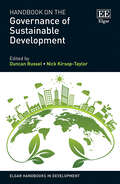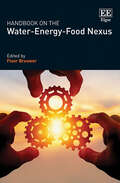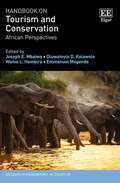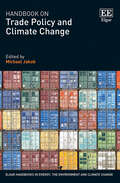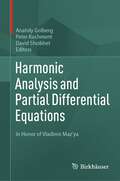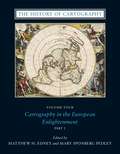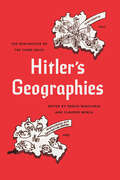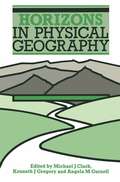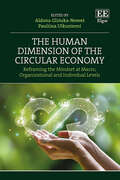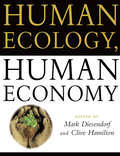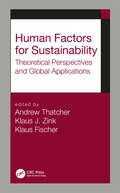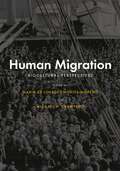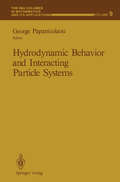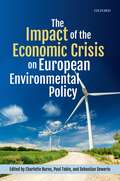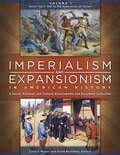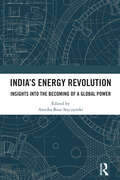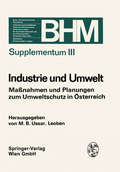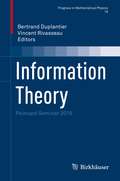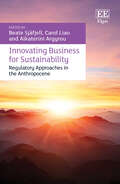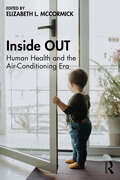- Table View
- List View
Handbook on the Governance of Sustainable Development (Elgar Handbooks in Development)
This Handbook brings together state-of-the-art contributions and international insights outlining the key theoretical developments and empirical findings related to sustainable development and governance. Providing both an overview and deep dive into the topic, it demonstrates how the concept of sustainable development and governance has led to multiple responses in both the academic and policy world from a theoretical, conceptual and operational viewpoint.Drawing on a wide range of perspectives, leading contributors examine global research on the governance of sustainable development, spanning disciplines including politics, public policy, international relations, environmental science and human geography. Providing an in-depth examination of current ongoing challenges such as climate change, trade and poverty, the Handbook investigates both collaborative approaches for sustainable development governance and policy innovation and integration. Furthermore, chapters utilise global case studies in action, exploring governance by international and non-government organisations and illustrating their key findings.Providing an interdisciplinary perspective, this Handbook will be a critical resource for research students of sustainable development and environmental governance as well as established researchers in the field. Scholars of politics and public policy will find the case studies informative and illuminating.
Handbook on the Water-Energy-Food Nexus
This Handbook provides a comprehensive overview of how water, energy and food are interconnected, comprising a coherent system: the nexus. It considers the interlinkages between natural resources, governance processes seeking coherence among water, energy and food policies, and the adoption of transdisciplinary approaches in the field.With contributions covering a broad range of disciplinary perspectives and cross-cutting themes, the Handbook has a well-balanced mix of conceptual chapters and empirical studies. It includes a state-of-the-art analysis of the concepts and experiences in implementing the nexus in different policy environments, providing examples of successful integrated decision-making across the domains of water, energy and food. Offering a global perspective on water, energy and food security, the Handbook contains insights into achieving both national development goals and the Sustainable Development Goals. Chapters further highlight how to understand the concepts of the nexus in practice, impacts of the nexus in governance, policy and business, and methods and tools to strengthen the nexus.Interdisciplinary and thorough, this Handbook will be critical reading for environmental management, public policy and human geography scholars. It will also be a useful tool for policymakers looking for successful examples of policy coherence towards an integrated management of water, energy and food resources.
Handbook on Tourism and Behaviour Change (Research Handbooks in Tourism series)
A must-read for researchers and practitioners focusing on how the tourism industry needs to evolve given the societal and sustainability challenges we face, this comprehensive Handbook serves as a vital reference point for advanced research in tourism and behaviour change. Chapters depict critical reviews and debates on the topic, comprising both theoretical and empirical research illustrated by international case studies to explore strategies for current and future challenges in the field.The Handbook explores why, while there is heightened debate surrounding the negative impacts of tourism, people tend to be psychologically distant from this problem when they travel, and greater efforts need to be made to encourage people to be socially and environmentally responsible. Leading contributors from across the globe show how and why tourists’ and residents’ behaviour change interventions need to be designed to align with the Sustainable Development Goals going forward, and how a thorough understanding of tourism settings is key to achieving desired behaviour change outcomes.With the COVID-19 pandemic encouraging a resurgence of interest in the topic, this timely Handbook will be a key resource for tourism scholars and students. The explorations of why behaviour change is important and when to implement interventions that are offered across the chapters will also be beneficial to tourism practitioners and policy makers.
Handbook on Tourism and Conservation: African Perspectives (Research Handbooks in Tourism series)
The Handbook on Tourism and Conservation demonstrates the intrinsic nexus between tourism, the environment and sustainable natural resources use. It applies Ostrom’s social-ecological systems (SESs) theory as the analytical framework for reaching a consensus on divergent viewpoints within the context of global environmental change and emerging governance issues.Reflecting the interdependency between tourism and biodiversity conservation, the book focuses on four thematic areas. These include tourism and conservation in protected areas; tourism and climate change; sustainable agritourism; and destination communities and natural resources conservation. Thus equity and environmental justice issues are highlighted in relation to how destination communities have benefitted from tourism activities. The Handbook will be a useful guide for policymakers and relevant institutions in the implementation of tourism policies that balance issues in tourism and environmental conservation equally and which in turn could enhance wider participation in tourism development by all stakeholders in the sector.The Handbook will be a valuable resource for academics, researchers and students of tourism studies, geography, environmental policy, management and related fields. It will also be beneficial for sustainable tourism policymakers and planners.
Handbook on Trade Policy and Climate Change (Elgar Handbooks in Energy, the Environment and Climate Change)
This insightful Handbook provides a comprehensive overview of the most recent developments in the academic debate on the numerous and complex linkages between international trade and climate change. Adopting a broad interdisciplinary approach, it brings together perspectives from scholars in economics, political science and legal studies to confront the critical environmental challenges posed by globalization. Initial chapters provide an overview of the key debates related to international trade and climate policy, engaging with empirical data from the US and China to assess the impact of new trade initiatives and policy on greenhouse gas emissions, carbon leakage and the increase of trade in carbon-intensive products. Contributors propose policy options that align international trade with climate change mitigation and address crucial legal and practical implications, including the implementation of Border Carbon Adjustments and international trade disputes. Offering critical and empirically-based perspectives on the future of international trade policy, this timely Handbook is crucial reading for scholars, researchers and graduate students in political science, public policy and climate research. Policymakers will also benefit from its unique and insightful policy recommendations.
Harmonic Analysis and Partial Differential Equations: In Honor of Vladimir Maz'ya
Over the course of his distinguished career, Vladimir Maz'ya has made a number of groundbreaking contributions to numerous areas of mathematics, including partial differential equations, function theory, and harmonic analysis. The chapters in this volume - compiled on the occasion of his 80th birthday - are written by distinguished mathematicians and pay tribute to his many significant and lasting achievements.
High and low pressure belts (Large Print)
The image on this page is of the Earth and shows belts of high and low pressure and prevailing winds. There is a locator dot shown, which will be at the top left of the page when the image is the right way up. There are labels to the left of the page. In the centre there is a disc with horizontal bands of texture representing the planet Earth with high and low air pressure areas. On the disc, there are curved lines with arrowheads showing the directions of prevailing winds. There is also a heavy dashed horizontal straight line showing the Equator with horizontal dashed lines up and down the page from this showing the tropics of Cancer and Capricorn. To the right of this are curved lines with arrowheads showing rising and descending air.
High and low pressure belts (UEB Contracted)
The image on this page is of the Earth and shows belts of high and low pressure and prevailing winds. There is a locator dot shown, which will be at the top left of the page when the image is the right way up. There are labels to the left of the page. In the centre there is a disc with horizontal bands of texture representing the planet Earth with high and low air pressure areas. On the disc, there are curved lines with arrowheads showing the directions of prevailing winds. There is also a heavy dashed horizontal straight line showing the Equator with horizontal dashed lines up and down the page from this showing the tropics of Cancer and Capricorn. To the right of this are curved lines with arrowheads showing rising and descending air.
High and low pressure belts (UEB Uncontracted)
The image on this page is of the Earth and shows belts of high and low pressure and prevailing winds. There is a locator dot shown, which will be at the top left of the page when the image is the right way up. There are labels to the left of the page. In the centre there is a disc with horizontal bands of texture representing the planet Earth with high and low air pressure areas. On the disc, there are curved lines with arrowheads showing the directions of prevailing winds. There is also a heavy dashed horizontal straight line showing the Equator with horizontal dashed lines up and down the page from this showing the tropics of Cancer and Capricorn. To the right of this are curved lines with arrowheads showing rising and descending air.
The History of Cartography, Volume 4: Cartography in the European Enlightenment (The History of Cartography #4)
Since its launch in 1987, the History of Cartography series has garnered critical acclaim and sparked a new generation of interdisciplinary scholarship. Cartography in the European Enlightenment, the highly anticipated fourth volume, offers a comprehensive overview of the cartographic practices of Europeans, Russians, and the Ottomans, both at home and in overseas territories, from 1650 to 1800. The social and intellectual changes that swept Enlightenment Europe also transformed many of its mapmaking practices. A new emphasis on geometric principles gave rise to improved tools for measuring and mapping the world, even as large-scale cartographic projects became possible under the aegis of powerful states. Yet older mapping practices persisted: Enlightenment cartography encompassed a wide variety of processes for making, circulating, and using maps of different types. The volume’s more than four hundred encyclopedic articles explore the era’s mapping, covering topics both detailed—such as geodetic surveying, thematic mapping, and map collecting—and broad, such as women and cartography, cartography and the economy, and the art and design of maps. Copious bibliographical references and nearly one thousand full-color illustrations complement the detailed entries.
Hitler's Geographies: The Spatialities of the Third Reich
Lebensraum: the entitlement of “legitimate” Germans to living space. Entfernung: the expulsion of “undesirables” to create empty space for German resettlement. During his thirteen years leading Germany, Hitler developed and made use of a number of powerful geostrategical concepts such as these in order to justify his imperialist expansion, exploitation, and genocide. As his twisted manifestation of spatial theory grew in Nazi ideology, it created a new and violent relationship between people and space in Germany and beyond. With Hitler’s Geographies, editors Paolo Giaccaria and Claudio Minca examine the variety of ways in which spatial theory evolved and was translated into real-world action under the Third Reich. They have gathered an outstanding collection by leading scholars, presenting key concepts and figures as well exploring the undeniable link between biopolitical power and spatial expansion and exclusion.
The Human Dimension of the Circular Economy: Reframing the Mindset at Macro, Organizational and Individual Levels
This enlightening book presents a framework of the various factors influencing the transformation of societal thinking towards the circular economy, including individual, organizational and macro-environmental levels of analysis.The Human Dimension of the Circular Economy delivers an array of diverse perspectives on the human aspects of the circular economy: one of the key models for building a more sustainable future. Chapters include contributions from esteemed international experts, exploring themes such as consumer perspectives on the circular economy, institutional and organisational catalysts and barriers to circular economy implementation, corporate entrepreneurship and the circular economy, and employee green behaviour. Looking ahead, this book proposes a blueprint for the forces, processes and mechanisms required to shape further circular economy mindset development, encouraging new avenues for its research.This book will be a vital read for students, academics and researchers focusing on corporate social responsibility, management and sustainability, marketing, organizational behaviour and sustainable development. Discussing practical issues of customer behaviour, business relationships and business ethics, it will also prove an interesting read for organization and business management professionals.
Human Ecology, Human Economy
'A brilliant synthesis of ecology and economics that provides a sure guide to a sustainable future. It is a must for all environmentalists and economists.'Charles Birch'Written by an impressive list of experts across a number of disciplines, this readable text provides not only analysis but vigorous criticism-and answers.'Robyn Williams'This book is such a useful guide to responsible decision-making that it should be supplied in bulk to senior government officials and managers in the private sector.'Ian Lowe'This is a fine contribution to ecological economics coming from Australia, and of interest worldwide.'Herman E DalyHuman well-being is wholly dependent upon the continued good health of the Earth s ecosystems. Human behaviour as it interacts with the biophysical environment is enormously complex, as governments (and individuals) who must make decisions about resource use are becoming increasingly aware. Human Ecology, Human Economy provides the basic concepts and tools for understanding how to analyse that interaction.The book is designed to be used as a text for undergraduate and graduate students in environmental studies, human and social ecology, ecological economics, futures studies, and science and technology studies. It is also intended for interested members of the public and for policy-makers working on environmental issues, especially where these intersect with economic policy.Human Ecology, Human Economy not only covers the basic concepts, but also moves to some of the frontiers of thinking in several case studies. It uses a problem and solution oriented approach which crosses disciplinary boundaries, drawing together elements from biology, economics, philosophy and political science.Professor Mark Diesendorf is Director of the Institute for Sustainable Futures at the University of Technology, Sydney and Vice President of the Sustainable Energy Industries Council of Australia. Among the books he has edited are The Magic Bullet and Energy And People.Dr Clive Hamilton is Executive Director of the Australia Institute, Canberra and teaches in the Public Policy Program at the Australian National University. His books include Capitalist Industrialisation In Korea, The Mystic Economist and The Economic Dynamics Of Australian Industry.
Human Factors for Sustainability: Theoretical Perspectives and Global Applications
This book deals with the central question of how human factors and ergonomics (HFE) might contribute to solutions for the more sustainable development of our world. The contents of the book are highly compatible with the recent political agenda for sustainable development as well as with sustainability research from other disciplines.The book aims to summarize and profile the various empirical and theoretical work arising from the field of “Human Factors and Sustainable Development” in the last decade. The book gives a systematic overview of relevant theoretical concepts, their underlying philosophies, as well as global application fields and case studies.
Human Migration: Biocultural Perspectives
Studying human migratory patterns can help us make sense of evolution, biology, linguistics, and so much more. Human Migration takes readers through population development and their respective origins to create a comprehensive picture of human migratory patterns. This book explores human migration as a major contributor to globalization that facilitates gene flow and the exchange of cultures and languages. It also traces evolutionary success of a hybrid population, the Black Caribs, after their forced relocation from St. Vincent Island to the Bay Islands and Central America. The volume is split into four sections: Theoretical Overview; Ancient DNA and Migration; Regional Migration; Culture and Migration: and Disease and Migration. This division allows for a seamless transition between a broad range of topics, including molecular genetics, linguistics, cultural anthropology, history, archaeology, demography, and genetic epidemiology. Assembled by volume editors and migration specialists María de Lourdes Muñoz-Moreno and Michael H. Crawford, Human Migration creates an opportunity for researchers, professionals, and students from different fields to review and discuss the most recent trends and challenges surrounding migration, genetics, and anthropology.
Hurricane areas of the world (Large Print)
This is a multi-page image of Hurricane areas of the world, set on two pages. There are locator dots shown, which will be at the top left of each page when the images are the right way up. Key to hurricane areas of the world: This page shows the key to the diagram of hurricane areas of the world. On the left hand side of the page is a list of abbreviations for the continents of the world, listed in alphabetical order. In the middle of the page, running from top to bottom, is a line dividing the two parts of the key from each other. On the right hand side of the page are examples of the symbols, lines and textures (colours) used on the diagram. They are displayed in a column in alphabetical order with descriptive labels to the right.Hurricane areas of the world:This page shows a map of the world bounded by a dashed line image border. The land is shown by the textured areas of the map. On the left of the page are, North and South America, in the centre Europe, and on the right Asia and Australia. The heavy dashed line of the Equator runs horizontally across the middle of the page. The hurricanes and their directions are shown on the map as lines with arrowheads, which curve clockwise when up the page from the Equator and anti-clockwise when down the page. There are three of them just above the line of the Equator on the left of the page. On the right of the page, there are six above the Equator and six below.
Hydrodynamic Behavior and Interacting Particle Systems (The IMA Volumes in Mathematics and its Applications #9)
This IMA Volume in Mathematics and its Applications HYDRODYNAMIC BEHAVIOR AND INTERACTING PARTICLE SYSTEMS is in part the proceedings of a workshop which was an integral part of the 1985-86 IMA program on STOCHASTIC DIFFERENTIAL EQUATIONS AND THEIR APPLICATIONS. We are grateful to the Scientific Committee: Daniel Stroock (Chairman) Wendell Fleming Theodore Harris Pierre-Louis Lions Steven Orey George Papanicolaou for planning and implementing an exciting and stimulating year-long program. We especially thank the Program Organizer, George Papanicolaou for orga nizing a workshop which brought together scientists and mathematicians in a variety of areas for a fruitful exchange of ideas. George R. Sell Hans Weinberger PREFACE A workshop on the hydrodynamic behavior of interacting particle systems was held at the Institute for Mathematics and its Applications at the University of Minnesota during the week of March 17, 1986. Fifteen papers presented at the workshop are collected in this volume. They contain research in several different directions that are currently being pursued. The paper of Chaikin, Dozier and Lindsay is concerned with experimental results on suspensions in regimes where modern mathematical methods could be useful. The paper of Fritz gives an introduction to these methods as does the paper of Spohn. Analytical methods currently used by in the physics and chemistry literature are presented in the paper of Freed, Wang and Douglas. The paper of Caflisch deals with time dependent effects in sedimentation.
The Impact of the Economic Crisis on European Environmental Policy
The European Union (EU) has sought to establish itself as a global environmental leader but was hit by the combined effects of the economic and financial crisis from 2007-8 leading some to question whether the EU could continue to adopt ambitious environmental policy. This volume brings together leading environmental policy scholars to analyse the impacts of the crisis upon environmental policy in the EU and its member states. Authors analyse whether environmental policy has been dismantled, expanded or stayed the same. If policy has been dismantled, the kind of strategy adopted is analysed (active, symbolic, arena-shifting, or dismantling by default), and at what levels change has occurred. The Index of Policy Activity (IPA) is applied systematically across the cases, which combine quantitative with qualitative analysis. Non-European cases are also included to provide a counterpoint for comparison. The book finds that whilst the EU has not actively dismantled environmental policy, its economic policies have had negative effects upon some Member States, prompting policy dismantling. Climate and energy policies have seen some policy expansion but there are examples, most notably the UK, where there has also been active policy dismantling. The main trend is one of stasis - environmental policy in Europe is judged to have plateaued calling into question Europe's much-vaunted environmental leadership. The book contributes to scholarship on environmental policy and public administration, combining empirical and methodological insights to give an up to date perspective on the impact of crisis upon European environmental policy.
Imperialism and Expansionism in American History [4 volumes]: A Social, Political, and Cultural Encyclopedia and Document Collection [4 volumes]
This four-volume encyclopedia chronicles the historical roots of the United States' current military dominance, documenting its growth from continental expansionism to hemispheric hegemony to global empire.This groundbreaking four-volume encyclopedia offers sweeping coverage of a subject central to American history and of urgent importance today as the nation wrestles with a global imperial posture and the long-term viability of the largest military establishment in human history. The work features more than 650 entries encompassing the full scope of American expansionism and imperialism from the colonial era through the 21st-century "War on Terror."Readers will learn about U.S.-Native American conflicts; 19th-century land laws; early forays overseas, for example, the opening of Japan; and America's imperial conflicts in Cuba and the Philippines. U.S. interests in Latin America are explored, as are the often-forgotten ambitions that lay behind the nation's involvement in the World Wars. The work also offers extensive coverage of the Cold War and today's ongoing conflicts in Iraq, Afghanistan, Africa, and the Middle East as they relate to U.S. national interests. Notable individuals, including American statesmen, military commanders, influential public figures, and anti-imperialists are covered as well. The inclusion of cultural elements of American expansionism and imperialism—for example, Hollywood films and protest music—helps distinguish this set from other more limited works.
India’s Energy Revolution: Insights into the Becoming of a Global Power
India is the third-largest emitter of greenhouse gases, which makes it an important player whose climate mitigation actions and inactions are closely scrutinised. This book studies developments in India’s energy system from a governance perspective. It presents a unique compilation and synthesis of research findings that capture achievements, shortcomings, and persistent and transient challenges of India’s transition towards a net-zero economy by 2070.The book grounds its analysis in domestically formulated goals and reflects on dynamics at the structural level of India’s multi-scalar innovation system, by highlighting the influencing factors of energy system status and change. It presents the perspectives and positions of different actor groups, studies the market and business, and discusses cases influenced by existing or changing institutions across the whole spectrum of energy resources from fossil to non-fossil fuels and respective technologies.The volume will be useful for students and researchers in energy governance, energy policy and economics, socio-technical transition studies, energy systems engineering, sustainable development, and environmental studies. It will also be of interest to policymakers and investors.
Industrie und Umwelt: Maßnahmen und Planung zum Umweltschutz in Österreich. Vortragsreihen veranstaltet von: Österreichische Gesellschaft zur Reinhaltung der Luft, Technisch- wissenschaftlicher Verein "Eisenhütte Österreich", Institutfür Wärmetechnik, Industrieofenbau und Ener (Berg- und Hüttenmännische Monatshefte Supplementa #3)
Information Theory: Poincaré Seminar 2018 (Progress in Mathematical Physics #78)
This eighteenth volume in the Poincaré Seminar Series provides a thorough description of Information Theory and some of its most active areas, in particular, its relation to thermodynamics at the nanoscale and the Maxwell Demon, and the emergence of quantum computation and of its counterpart, quantum verification. It also includes two introductory tutorials, one on the fundamental relation between thermodynamics and information theory, and a primer on Shannon's entropy and information theory. The book offers a unique and manifold perspective on recent mathematical and physical developments in this field.
Innovating Business for Sustainability: Regulatory Approaches in the Anthropocene
Challenging current attitudes to governance and regulation in business, this timely book ascertains how regulatory approaches can innovate to ensure sustainable business that contributes to social justice for current and future generations within ecological limits.Combining a research-based approach with a gendered perspective of how sustainability goals are shaped and how businesses should engage with them, this pioneering book creates a comprehensive and contemporary understanding of what sustainability means for business. Identifying the limitations of current approaches to gender and equality alongside the weaknesses of current regulatory and theoretical approaches in business, chapters seek to enhance the practical understanding and embeddedness of sustainability into business within legal and regulatory landscapes. Insights from an international collection of expert scholars in fields ranging from sustainability science to law offer meaningful alternatives to the sustainable business status quo on both conceptual and concrete levels.Providing a regulatory analysis of business positioned in a systems-based sustainability research framework, this book will prove an invaluable resource for students and scholars of sustainability science, business and management, and law and regulation. With practical insights, it will also prove essential for policymakers working in business regulation and sustainability in business.
Inside OUT: Human Health and the Air-Conditioning Era
Inside OUT: Human Health and the Air-Conditioning Era focuses on the enclosed environment of fully conditioned buildings, revealing a unique ecosystem with broad implications for human life and a rapidly expanding global footprint. Emphasizing the interconnections between buildings and human health, equity, and environmental sustainability, it presents an interdisciplinary, holistic analysis of the social, behavioral, and technological issues of indoor space.Over the 20th century, advances in mechanical conditioning technologies led to the dispersion and international dominance of the sealed building envelope, which casually and progressively disconnected buildings and their occupants from local climatic, biological, and cultural environments. At the same time, humans were increasingly pushed indoors by less tangible, socially constructed forces that associated climate control with cleanliness, health, social status, and modernization.In this volume, a multi-disciplinary group of experts on the indoor microbiome from the fields of biology, anthropology, and architecture come together to thoughtfully reflect on the history, properties, and meaning of indoor air quality in buildings, and to discuss the future of human habitation – with a dominant focus on human health in a post-pandemic world. Taking a human-first approach to health and sustainability, the authors weave together a compelling analysis of social and technological drivers of conditioned space with arguments for future interventions in the built environment.Amid growing awareness of air quality and climate concerns, Inside OUT provides a timely discussion of the relationship between building design and human health, of relevance to professional and academic readers from across the spectrum of the building industry, as well as fields including public health and environmental studies.
